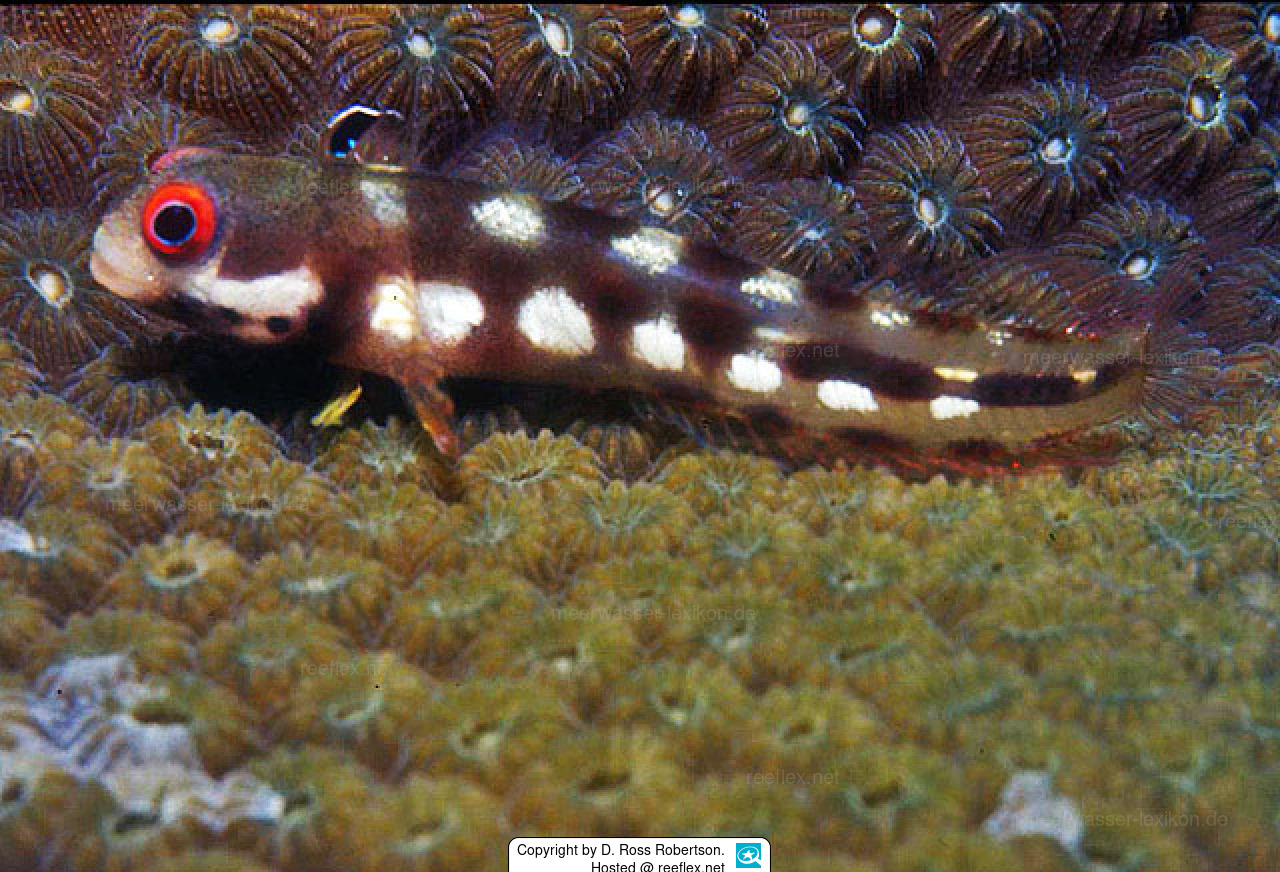Info
Stephens, 1970
Acanthemblemaria rivasi lives in abandoned worm tubes in bottoms ranging from muddy rock to live massive corals.
Body elongate; short blunt head; very short blunt spines from snout back to join a rounded patch behind eyes, none on rear of nape; cirri on nostrils, over eyes (1 pair, unbranched), but not on nape; multiple rows of well-developed teeth on side of roof of mouth; dorsal fin XXI-XXII, 11-13, a notch between spiny and soft parts; anal fin II, 21-24; pelvics I (internal), 2-3, inserted before pectoral base; all fin rays unbranched; no lateral line; no scales.
Upper head and body greenish-brown; iris bright red, with an inner white ring; head tan above, blackish below, often densely speckled with tiny blue dots; sometimes a white stripe under eye along cheek; body with 3 rows of 5-10 dark spots (along top & bottom profiles, and central flank), alternating with 1-2 rows of white to pale blotches; a black spot between 1st 2 dorsal fin spines.
Source: Shorefishes of the Greater Caribbean online information
Classification: Biota > Animalia (Kingdom) > Chordata (Phylum) > Vertebrata (Subphylum) > Gnathostomata (Superclass) > Pisces (Superclass) > Actinopteri (Class) > Perciformes (Order) > Blennioidei (Suborder) > Chaenopsidae (Family) > Acanthemblemaria (Genus) > Acanthemblemaria rivasi (Species)
Jumping guard
A jumping guard prevents (nocturnal) fish from jumping out.
Wrasses, blennies, hawkfishs and gobies jump out of an unprotected tank in fright if their night rest is disturbed, unfortunately these jumpers are found dried up in the morning on carpets, glass edges or later behind the tank.
https://www.korallenriff.de/en/article/1925_5_Jump_Protection_Solutions_for_Fish_in_the_Aquarium__5_Net_Covers.html
A small night light also helps, as it provides the fish with a means of orientation in the dark!
Acanthemblemaria rivasi lives in abandoned worm tubes in bottoms ranging from muddy rock to live massive corals.
Body elongate; short blunt head; very short blunt spines from snout back to join a rounded patch behind eyes, none on rear of nape; cirri on nostrils, over eyes (1 pair, unbranched), but not on nape; multiple rows of well-developed teeth on side of roof of mouth; dorsal fin XXI-XXII, 11-13, a notch between spiny and soft parts; anal fin II, 21-24; pelvics I (internal), 2-3, inserted before pectoral base; all fin rays unbranched; no lateral line; no scales.
Upper head and body greenish-brown; iris bright red, with an inner white ring; head tan above, blackish below, often densely speckled with tiny blue dots; sometimes a white stripe under eye along cheek; body with 3 rows of 5-10 dark spots (along top & bottom profiles, and central flank), alternating with 1-2 rows of white to pale blotches; a black spot between 1st 2 dorsal fin spines.
Source: Shorefishes of the Greater Caribbean online information
Classification: Biota > Animalia (Kingdom) > Chordata (Phylum) > Vertebrata (Subphylum) > Gnathostomata (Superclass) > Pisces (Superclass) > Actinopteri (Class) > Perciformes (Order) > Blennioidei (Suborder) > Chaenopsidae (Family) > Acanthemblemaria (Genus) > Acanthemblemaria rivasi (Species)
Jumping guard
A jumping guard prevents (nocturnal) fish from jumping out.
Wrasses, blennies, hawkfishs and gobies jump out of an unprotected tank in fright if their night rest is disturbed, unfortunately these jumpers are found dried up in the morning on carpets, glass edges or later behind the tank.
https://www.korallenriff.de/en/article/1925_5_Jump_Protection_Solutions_for_Fish_in_the_Aquarium__5_Net_Covers.html
A small night light also helps, as it provides the fish with a means of orientation in the dark!







 Dr. D. Ross Robertson, Panama
Dr. D. Ross Robertson, Panama


















